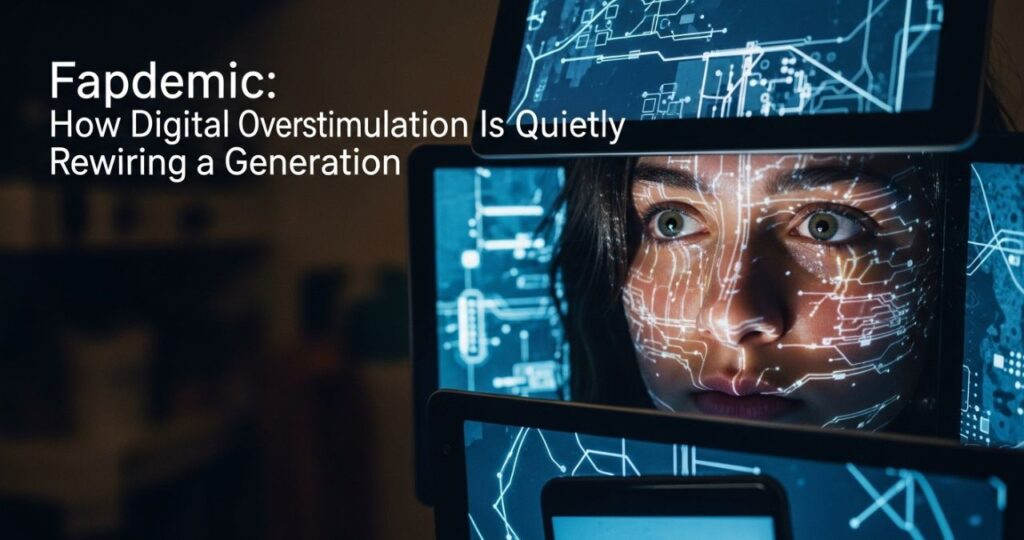In the hyperconnected 21st century, humanity is facing a silent, yet profound digital crisis — one that few are openly discussing but nearly everyone is affected by. It’s called the Fapdemic — a term that encapsulates the mass overstimulation of the modern brain caused by an endless flood of explicit content, algorithm-driven gratification, and dopamine-saturated digital experiences. Unlike pandemics of the past, this one doesn’t spread through the air or water — it spreads through screens, clicks, and the human craving for instant pleasure.
This phenomenon is not just about adult entertainment; it’s about a wider shift in how technology hijacks human attention, rewires neural pathways, and distorts expectations about connection, reward, and reality itself. The Fapdemic represents the dark side of digital evolution — where convenience, curiosity, and compulsion collide in a virtual feedback loop of endless stimulation.
The Rise of the Fapdemic
The origins of the Fapdemic lie in the exponential rise of digital technology over the past two decades. As high-speed internet, smartphones, and streaming platforms became ubiquitous, access to explicit material exploded. What was once hidden behind magazine covers or paywalls became available with a single tap.
Platforms optimized for engagement — from social media to adult sites — began using advanced algorithms designed to keep users hooked. These algorithms learn patterns of arousal, interest, and curiosity, and then feed increasingly personalized and extreme content to maintain engagement.
While this may sound like a technical innovation, it has profound psychological implications. The brain’s reward circuitry, primarily driven by dopamine, isn’t equipped to handle constant, intense stimulation. Over time, the threshold for pleasure increases — users need more novelty, more intensity, and more time online to achieve the same satisfaction. This is the essence of the Fapdemic: overstimulation leading to desensitization.
Digital Dopamine: The Neurochemistry of the Fapdemic
To understand how the Fapdemic rewires the brain, it’s essential to understand dopamine — the neurotransmitter responsible for motivation and reward. In moderation, dopamine drives ambition, curiosity, and the pursuit of goals. But when the brain is bombarded with rapid, artificial spikes in dopamine, the reward system begins to malfunction.
Modern digital platforms — especially those with explicit or highly stimulating visual content — flood the brain with dopamine. This repeated flooding causes a “tolerance” effect similar to that observed in drug addiction. The brain’s natural response is to downregulate dopamine receptors, meaning that normal, everyday pleasures (like studying, exercising, or socializing) no longer feel rewarding.
In essence, the brain gets “hijacked.” The user’s focus narrows to short-term gratification rather than long-term fulfillment. This rewiring doesn’t just affect sexual behavior — it affects motivation, relationships, and even attention span. That’s why many psychologists now consider the Fapdemic not just a moral or social issue, but a neurological one.
The Social Consequences of the Fapdemic
The effects of the Fapdemic ripple far beyond individual habits. It’s reshaping cultural norms, interpersonal relationships, and perceptions of intimacy.
For many young people growing up online, digital content becomes their first — and often primary — exposure to ideas about romance and sexuality. Unfortunately, these depictions are often exaggerated, transactional, or emotionally detached. As a result, an entire generation is learning about connection through distorted filters.
Studies have begun to show correlations between high levels of explicit content consumption and issues such as:
-
Reduced relationship satisfaction
-
Unrealistic expectations about sex and body image
-
Difficulty forming emotional intimacy
-
Increased anxiety and depression
Moreover, the broader digital ecosystem reinforces similar patterns. Platforms like TikTok, Instagram, and YouTube Shorts thrive on microbursts of stimulation — endless loops of entertainment designed to keep users scrolling. The overlap between these mainstream platforms and more adult-oriented spaces blurs boundaries between normal curiosity and addictive compulsion.
The result? A generation that’s overstimulated but underconnected.
Fapdemic and Attention Fragmentation
One of the most alarming side effects of the Fapdemic is the collapse of sustained attention.
Neuroscientists have noted that overstimulation reduces the brain’s ability to focus for extended periods. The constant switching between apps, videos, and tabs trains the mind for fragmentation rather than depth. This digital multitasking erodes working memory, reduces learning efficiency, and fosters chronic impatience.
For young people, this manifests as difficulty reading books, maintaining concentration in class, or engaging in long-term projects. The mind, accustomed to quick dopamine bursts, perceives slower rewards as “boring.” Over time, this can diminish creativity, empathy, and resilience — core human traits that require mental stillness and focus to flourish.
In the context of the Fapdemic, this fragmentation is even more severe because the reward at stake is tied to primal drives — sexual curiosity and gratification — which the brain treats as top-priority motivators. That combination of primal impulse and digital immediacy creates an exceptionally potent behavioral loop.
Breaking the Cycle: Reclaiming the Mind
The Fapdemic isn’t an inevitable fate — it’s a challenge that can be confronted through awareness, boundaries, and conscious reprogramming. The first step is understanding that this is not simply about morality or guilt; it’s about mental hygiene and digital health.
Here are key strategies individuals and families can use to resist the effects of the Fapdemic:
-
Digital Detox and Dopamine Reset
Schedule regular breaks from screens. Even a few hours of offline time daily can help restore dopamine balance. Extended “dopamine detoxes” — weekends without social media, gaming, or explicit material — can reset sensitivity to natural pleasures. -
Mindful Consumption
Approach all digital content — not just explicit material — with mindfulness. Ask: “Why am I watching this?” “What feeling am I chasing?” Awareness weakens the automatic loop of compulsive behavior. -
Reintroduce Real Rewards
Replace digital stimulation with activities that engage the body and mind: exercise, creative hobbies, deep reading, or meaningful social interactions. These trigger slower but more sustainable dopamine responses. -
Education and Communication
Parents, teachers, and mentors need to have open, nonjudgmental conversations about digital overstimulation. Shame only drives behavior underground; empathy and guidance promote understanding and control. -
Redesigning the Digital Environment
On a societal level, tech companies must take responsibility for the psychological effects of their algorithms. Features like time limits, content filters, and user well-being metrics can mitigate the most harmful patterns of overstimulation.
The Psychological Cost of the Fapdemic
Beyond its neurological and behavioral dimensions, the Fapdemic also carries an emotional toll. Many individuals caught in cycles of digital compulsion report feelings of guilt, isolation, and disconnection from reality.
Ironically, the very platforms designed to simulate connection often deepen loneliness. When intimacy becomes something mediated entirely by pixels and performance, authentic human touch begins to lose its value. People start to crave validation more than genuine connection, confusing attention with affection.
Therapists note that addressing these symptoms requires more than just abstaining from certain websites — it requires rebuilding one’s capacity for vulnerability, patience, and presence. Recovery isn’t about repression; it’s about rebalancing.
A Cultural Turning Point
The Fapdemic is forcing society to confront a deeper truth: technology evolves faster than human psychology. We have built machines that can outpace our evolutionary wiring — and now we’re paying the price.
However, just as previous generations adapted to the printing press, television, and the internet, we too can adapt. The key is not rejection but regulation — finding balance between digital pleasure and human purpose.
Some communities and movements are already responding. “NoFap” challenges, mindfulness-based digital wellness programs, and neuroscience-informed therapy approaches are helping individuals regain control. Governments are also exploring new digital well-being frameworks aimed at protecting minors and promoting healthy online habits.
Conclusion: The Future Beyond the Fapdemic
The Fapdemic is not about demonizing technology or human desire — it’s about recognizing how unchecked digital overstimulation can erode the foundations of mental and emotional well-being. It’s a wake-up call to reclaim focus, discipline, and genuine connection in a world designed for distraction.






